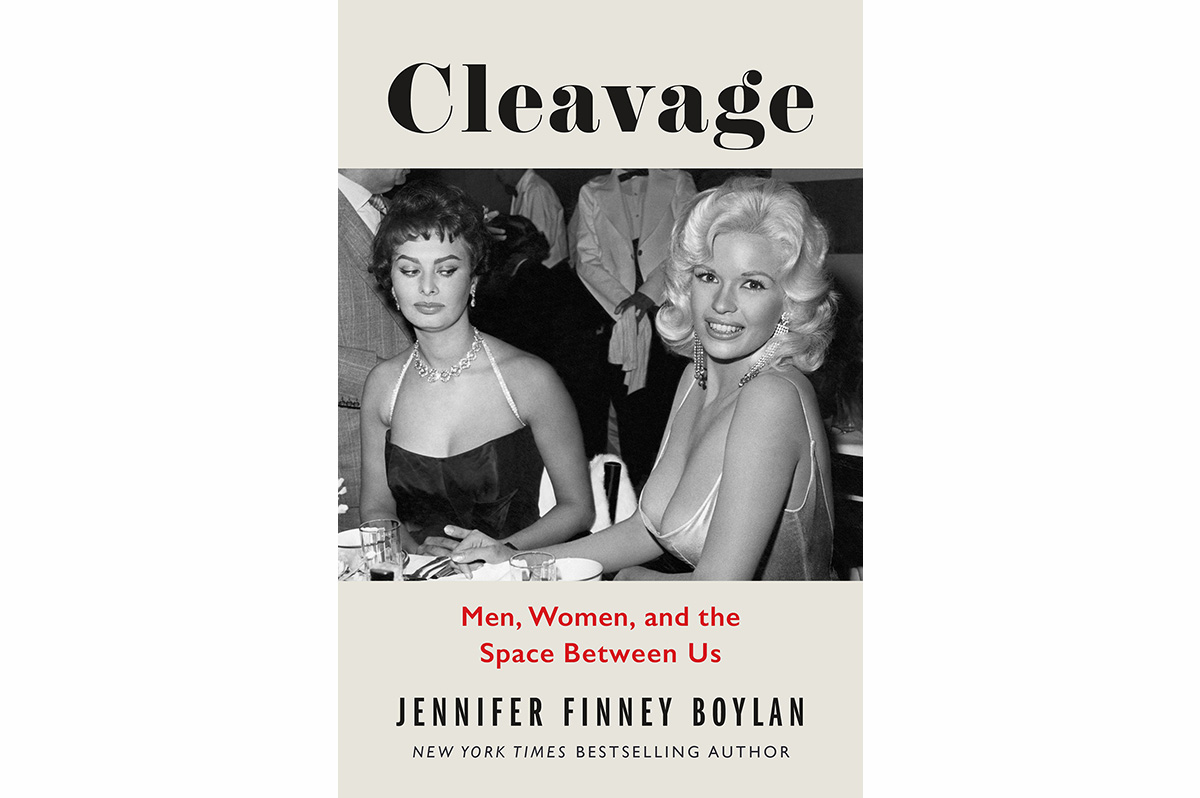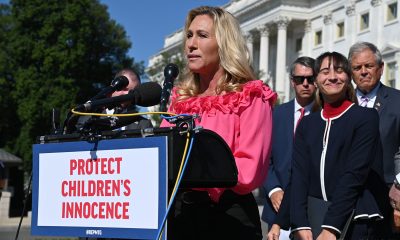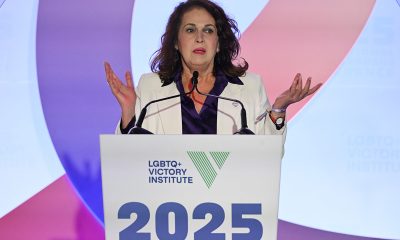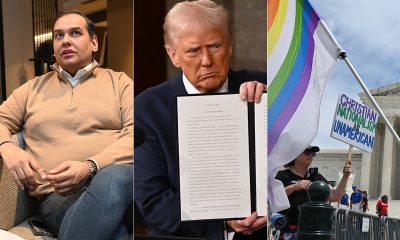Books
Jennifer Finney Boylan busts through hate with ‘Cleavage’
Bestselling author, scholar promoted latest book in D.C. in February

When bestselling author Jennifer Finney Boylan came to D.C. earlier this month to promote her new memoir, “Cleavage,” she chose an on-stage partner with whom she has some history, to pose questions before a gaggle of book lovers, members of the LGBTQ community and fans. Transgender Delaware Congresswoman Sarah McBride provided a bookend of sorts, given that Boylan fulfilled that same role when McBride published her first memoir, “Tomorrow Will Be Different.”
“Jenny moderated the first discussion when my book came out in 2018 at the Strand in New York City,” McBride said. “And I was star-struck. I was intimidated, because you were, really, for me, the first contemporary example of a trans person that wasn’t, as you write about in this book, on ‘Jerry Springer.’ Being exploited.”
“And that’s the hardest thing, I think, that some of us experience when we were growing up,” said Boylan. “At least for me, it was, I almost never saw anybody like me on TV or in the movies. And if there was anyone even vaguely like me, they were usually either a villain or someone who was a figure of ridicule. Thank goodness all that has changed!” The crowd laughed along, knowingly.
But it was not just McBride who joined Boylan in the Politics and Prose bookstore at the Wharf. They were joined by other trans trailblazers: Activist Mara Keisling, Adm. (ret.) Rachel Levine, former Department of Defense official Amanda Simpson and journalist and activist Charlotte Clymer.
This event was just one stop on a whirlwind national tour to promote Boylan’s book, featuring Roxane Gay in New York, WBUR senior arts and culture reporter Cristela Guerra in Cambridge, and other stops with celebrity guests from Maine to Santa Cruz, Calif.
Boylan has explained at each stop what compelled her to write a sequel to her bestselling first memoir, “She’s Not There: A Life in Two Genders,” from 2003.
“If you’re a writer, stories are my bread and butter,” she said. “And there are a lot of stories I haven’t told. There are also some stories I wanted to revisit.”
“Cleavage,” she revealed, was to acknowledge that things have changed since she told the world she was trans.
“One of the stories I wanted to look at was the difference between coming out now and coming out 25 years ago,” said Boylan. “I have a transgender daughter. She came out six or seven years ago. And how did I react? I freaked out. Did I put my arms around my child and say, ‘Love will prevail?’ No. I remember literally jolting in my chair. Literally. It was as if I had been struck by lightning. And my first thought was, ‘Damn.’ Because, as most of us know, it’s a hard life. And even when things go about as well as they can, which I think—and there are a lot of success stories in this room—it’s still a hard life.”
After conversations with the author at these events, the hosts have opened the floor to questions from the audience, often not just about Boylan’s memoir but about the state of affairs in Washington and across the nation.
At the event at the New York Public Library earlier this month, Gay fielded this question from someone who moderates a trans nonbinary peer support group: “What can you tell our members to give them hope?” Boylan took a moment to consider the question.
“Here’s what we know. Right now, things are really bad. And they’re not just bad for queer and nonbinary and trans people. They’re bad for a lot of people. They’re bad for anybody who doesn’t kind of fit into this 1950s all-male review of singing and dancing that these people have prepared for us. It is hard,” she said.
“We have been through hard times before in this country. We have been through a civil war. We’ve been through depression. We’ve been through, well, you know, the shit keeps hitting the fan. But this moment, as aggressive as it feels, will not last forever. And this will not define us. And I think that, what’s that Paul Simon song? ‘I believe in the future we will suffer no more. Maybe not in my lifetime, but in yours, I feel sure.’” Boylan was referencing the 1990 song, ‘The Cool, Cool River’ by Paul Simon. “Oh, gee, do I have to be dead for things to get better? I hope not,” added Boylan, before continuing her message.
“This moment, which feels so oppressive, is not the last word,” she said. “This is just beginning. And we have not, unfortunately, we have not yet started to fight back. But we are going to fight back. And, you know, I hope I can say they don’t know what’s coming for them! So, let’s make that clear. Is this really what the majority of Americans wanted? This? I don’t believe it. I won’t believe it. And so, we just have to work for it and not lose our hope. And, yeah, keep telling your stories.”
Simpson told her story at the event in D.C., comparing how the movement for marriage equality differs from the movement for trans rights.
“It was about the neighbors you know, and that there were LGBT people in your neighborhood,” she said. “I was an aerospace engineer. We had firemen and policemen. We had military people, all doing these ads saying, ‘Look, we’re just your neighbors. Get to know the individual, not this larger concept of an LGBT person,’ and that worked. And I think we have to do that again. It’s about that personal introduction to them. We do these things to show that we’re just like everyone else. We’re human. But we have a leader sitting down the street who has made this such a sharp point to help energize or misdirect what’s going on. And being a Jewish woman, I remember—well, not personally, but I look back at what happened in 1933 and 35 overseas and think about the similarities of picking on one group of defenseless, underrepresented people to help focus everyone else to be behind you. And that’s, I think, what we’re seeing.”
Levine, a former assistant secretary of Health and Human Services in the Biden-Harris administration, followed-up.
“I would agree with Amanda about the political aspect of this, it’s been very well reported that this is a specific strategy, an iterative strategy developed by right-wing think tanks in Washington to split the progressive movement,” Levine said. “They lost marriage, did not feel that they could gain that back, and so they were looking for a scapegoat, and thought that they could make progress by demonizing us and otherizing us, starting with trans athletes, then going on to transgender medicine or gender-affirming care for youth, and now you see, you know, denying that we exist at all, and then potentially trying to go back to sexual orientation as well … It was a specific political and ideological strategy which, unfortunately, they weaponized and were very successful in doing that, and I think that we were conveniently there, but now, what do we do? Now here we are, in this extremely challenging environment, and the key will be how our community, supported by the broader LGBTQ community and our allies, respond.”
Keisling pointed part of the blame for right-wing attacks on the community itself, for its handling of trans athletes and its hyperfocus on JK Rowling, who she called “a jerk.”
“They landed on this sports thing, which we totally screwed up,” said Keisling. “Instead of talking about the seven-year-old who wants to play soccer with her friends, we were talking about Olympians and NCAA swimmers, which we should have been defending against, but that wasn’t our strongest argument. What I have been saying for 10 years is we don’t seem to understand, we as progressives, that we are also part of the problem. We are not focused on what narrowness we’re hearing. Now, I believe this is about populism and politics, as Amanda said. But they came over and started picking people off on our side, and we have never done that. Progressives won’t do that. Progressives will never, ever, ever welcome somebody to come over from the other side. And that’s a mistake, and we’ve got to figure out how to do that, how to reach out to people, how to win over people. And once we win them over, we have to fucking embrace them. And most of the activists I know won’t do that.”
McBride stepped in to concur.
“I agree with you, Mara,” she said, “I think we have lost the art of coalition building. We have created a space where there is no room for imperfect allies. We have eliminated space for people to grow because they at least perceive that they will be seen as permanently guilty for having been wrong.”
Clymer agreed.
“Say what you will about the Evangelical Church, and I have a lot of things to say about the Evangelical Church, but their greatest strength is that there is a very low threshold for entry,” she said. “You show up to the congregations, you don’t have to know anything, you don’t have to have any knowledge of theory or practice or whatever, you just show up and you’re welcome to the pulpit. We as a progressive movement, and I think to your point, Mara, we do not do a very good job of keeping a welcome threshold for entry into the movement. We tell folks that if you don’t know this sort of thing, or this theory, or if you’re not aware of this or that or whatever, we make people afraid to err, make mistakes. And I do think we need to get better at that.”
Boylan got the last word.
“I think that we were defined with some of the hardest issues to understand. And rather than the fact that, you know, I don’t particularly want to play sports with your kid. I want to teach them English,” she said, then turned to McBride. “You are not here to play sports. You are here to represent the people of Delaware. So, the main thing we want is we want to be able to do our jobs. We want to be able to walk tall. And guess what? We also would like to be left alone.”
Boylan was asked if there was a bumper sticker for trans rights that could match what “Love is Love” accomplished for marriage equality. Her response: “Love is the wise person’s revenge. Love is the best revenge in the world.”

This past year, you’ve often had to make do.
Saving money here, resources there, being inventive and innovative. It’s a talent you’ve honed, but isn’t it time to have the best? Yep, so grab these Ten Best of 2025 books for your new year pleasures.
Nonfiction
Health care is on everyone’s mind now, and “A Living: Working-Class Americans Talk to Their Doctor” by Michael D. Stein, M.D. (Melville House, $26.99) lets you peek into health care from the point of view of a doctor who treats “front-line workers” and those who experience poverty and homelessness. It’s shocking, an eye-opening book, a skinny, quick-to-read one that needs to be read now.
If you’ve been doing eldercare or caring for any loved one, then “How to Lose Your Mother: A Daughter’s Memoir” by Molly Jong-Fast (Viking, $28) needs to be in your plans for the coming year. It’s a memoir, but also a biography of Jong-Fast’s mother, Erica Jong, and the story of love, illness, and living through the chaos of serious disease with humor and grace. You’ll like this book especially if you were a fan of the author’s late mother.
Another memoir you can’t miss this year is “Between the Devil and the Deep Blue Sea: A Veteran’s Memoir” by Khadijah Queen (Legacy Lit, $30.00). It’s the story of one woman’s determination to get out of poverty and get an education, and to keep her head above water while she goes below water by joining the U.S. Navy. This is a story that will keep you glued to your seat, all the way through.
Self-improvement is something you might think about tackling in the new year, and “Replaceable You: Adventures in Human Anatomy” by Mary Roach (W.W. Norton & Company, $28.99) is a lighthearted – yet real and informative – look at the things inside and outside your body that can be replaced or changed. New nose job? Transplant, new dental work? Learn how you can become the Bionic Person in real life, and laugh while you’re doing it.
The science lover inside you will want to read “The Grave Robber: The Biggest Stolen Artifacts Case in FBI History and the Bureau’s Quest to Set Things Right” by Tim Carpenter (Harper Horizon, $29.99). A history lover will also want it, as will anyone with a craving for true crime, memoir, FBI procedural books, and travel books. It’s the story of a man who spent his life stealing objects from graves around the world, and an FBI agent’s obsession with securing the objects and returning them. It’s a fascinating read, with just a little bit of gruesome thrown in for fun.
Fiction
Speaking of a little bit of scariness, “Don’t Forget Me, Little Bessie” by James Lee Burke (Atlantic Monthly Press, $28) is the story of a girl named Bessie and her involvement with a cloven-hooved being who dogs her all her life. Set in still-wild south Texas, it’s a little bit western, part paranormal, and completely full of enjoyment.
“Evensong” by Stewart O’Nan (Atlantic Monthly Press, $28) is a layered novel of women’s friendships as they age together and support one another. The characters are warm and funny, there are a few times when your heart will sit in your throat, and you won’t be sorry you read it. It’s just plain irresistible.
If you need a dark tale for what’s left of a dark winter season, then “One of Us” by Dan Chaon (Henry Holt, $28), it it. It’s the story of twins who become orphaned when their Mama dies, ending up with a man who owns a traveling freak show, and who promises to care for them. But they can’t ever forget that a nefarious con man is looking for them; those kids can talk to one another without saying a word, and he’s going to make lots of money off them. This is a sharp, clever novel that fans of the “circus” genre shouldn’t miss.
“When the Harvest Comes” by Denne Michele Norris (Random House, $28) is a wonderful romance, a boy-meets-boy with a little spice and a lot of strife. Davis loves Everett but as their wedding day draws near, doubts begin to creep in. There’s homophobia on both sides of their families, and no small amount of racism. Beware that there’s some light explicitness in this book, but if you love a good love story, you’ll love this.
Another layered tale you’ll enjoy is “The Elements” by John Boyne (Henry Holt, $29.99), a twisty bunch of short stories that connect in a series of arcs that begin on an island near Dublin. It’s about love, death, revenge, and horror, a little like The Twilight Zone, but without the paranormal. You won’t want to put down, so be warned.
If you need more ideas, head to your local library or bookstore and ask the staff there for their favorite reads of 2025. They’ll fill your book bag and your new year with goodness.
Season’s readings!
The Blade may receive commissions from qualifying purchases made via this post.
Books
This gay author sees dead people

‘Are You There Spirit? It’s Me, Travis’
By Travis Holp
c.2025, Spiegel and Grau
$28/240 pages
Your dad sent you a penny the other day, minted in his birth year.
They say pennies from heaven are a sign of some sort, and that makes sense: You’ve been thinking about him a lot lately. Some might scoff, but the idea that a lost loved one is trying to tell you he’s OK is comforting. So read the new book, “Are You There, Spirit? It’s Me, Travis” by Travis Holp, and keep your eyes open.

Ever since he was a young boy growing up just outside Dayton, Ohio, Travis Holp wanted to be a writer. He also wanted to say that he was gay but his conservative parents believed his gayness was some sort of phase. That, and bullying made him hide who he was.
He also had to hide his nascent ability to communicate with people who had died, through an entity he calls “Spirit.” Eventually, though it left him with psychological scars and a drinking problem he’s since overcome, Holp was finally able to talk about his gayness and reveal his otherworldly ability.
Getting some people to believe that he speaks to the dead is still a tall order. Spirit helps naysayers, as well as Holp himself.
Spirit, he says, isn’t a person or an essence; Spirit is love. Spirit is a conduit of healing and energy, speaking through Holp in symbolic messages, feelings, and through synchronistic events. For example, Holp says coincidences are not coincidental; they’re ways for loved ones to convey messages of healing and energy.
To tap into your own healing Spirit, Holp says to trust yourself when you think you’ve received a healing message. Ignore your ego, but listen to your inner voice. Remember that Spirit won’t work on any fixed timeline, and its only purpose is to exist.
And keep in mind that “anything is possible because you are an unlimited being.”
You’re going to want very much to like “Are You There, Spirit? It’s Me, Travis.” The cover photo of author Travis Holp will make you smile. Alas, what you’ll find in here is hard to read, not due to content but for lack of focus.
What’s inside this book is scattered and repetitious. Love, energy, healing, faith, and fear are words that are used often – so often, in fact, that many pages feel like they’ve been recycled, or like you’ve entered a time warp that moves you backward, page-wise. Yes, there are uplifting accounts of readings that Holp has done with clients here, and they’re exciting but there are too few of them. When you find them, you’ll love them. They may make you cry. They’re exactly what you need, if you grieve. Just not enough.
This isn’t a terrible book, but its audience might be narrow. It absolutely needs more stories, less sentiment; more tales, less transcendence and if that’s your aim, go elsewhere. But if your soul cries for comfort after loss, “Are You There, Spirit? It’s Me, Travis” might still make sense.
The Blade may receive commissions from qualifying purchases made via this post.
Books
‘Dogs of Venice’ looks at love lost and rediscovered
A solo holiday trip to Italy takes unexpected turn

‘The Dogs of Venice’
By Steven Crowley
c.2025, G.P. Putnam & Sons
$20/65 pages
One person.
Two, 12, 20, you can still feel alone in a crowded room if it’s a place you don’t want to be. People say, though, that that’s no way to do the holidays; you’re supposed to Make Merry, even when your heart’s not in it. You’re supposed to feel happy, no matter what – even when, as in “The Dogs of Venice” by Steven Rowley, the Christmas tinsel seems tarnished.

Right up until the plane door closed, Paul held hope that Darren would decide to come on the vacation they’d planned for and saved for, for months.
Alas, Darren was a no-show, which was not really a surprise. Three weeks before the departure, he’d announced that their marriage wasn’t working for him anymore, and that he wanted a divorce. Paul had said he was going on the vacation anyhow. Why waste a perfectly good flight, or an already-booked B&B? He was going to Venice.
Darren just rolled his eyes.
Was that a metaphor for their entire marriage? Darren had always accused Paul of wanting too much. He indicated now that he felt stifled. Still, Darren’s unhappiness hit Paul broadside and so there was Paul, alone in a romantic Italian city, fighting with an espresso machine in a loft owned by someone who looked like a frozen-food spokeswoman.
He couldn’t speak or understand Italian very well. He didn’t know his way around, and he got lost often. But he felt anchored by a dog.
The dog – he liked to call it his dog – was a random stray, like so many others wandering around Venice unleashed, but this dog’s confidence and insouciant manner inspired Paul. If a dog could be like that, well, why couldn’t he?
He knew he wasn’t unlovable but solo holidays stunk and he hated his situation. Maybe the dog had a lesson to teach him: could you live a wonderful life without someone to watch out for, pet, and care for you?
Pick up “The Dogs of Venice,” and you might think to yourself that it won’t take long to read. At under 100 pages, you’d be right – which just gives you time to turn around and read it again. Because you’ll want to.
In the same way that you poke your tongue at a sore tooth, author Steven Rowley makes you want to remember what it’s like to be the victim of a dead romance. You can do it here safely because you simply know that Paul is too nice for it to last too long. No spoilers, though, except to say that this novel is about love – gone, resurrected, misdirected – and it unfolds in exactly the way you hope it will. All in a neat evening’s worth of reading. Perfect.
One thing to note: the Christmas setting is incidental and could just as well be any season, which means that this book is timely, no matter when you want it. So grab “The Dogs of Venice,” enjoy it twice with your book group, with your love, or read it alone.
The Blade may receive commissions from qualifying purchases made via this post.

















